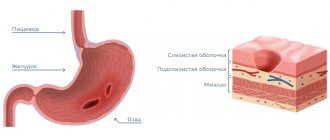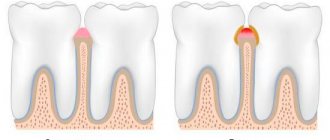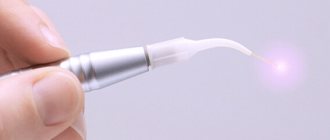Oral anatomy
The oral cavity is the beginning of the digestive apparatus. The oral cavity is divided into two sections by the alveolar processes of the jaws and teeth: the vestibule of the mouth and the oral cavity itself.
The vestibule of the mouth is the space located between the lips and cheeks on the outside and the teeth and gums on the inside. The vestibule of the mouth opens outward through the oral opening. The transverse oral fissure is limited by the lips, which are muscle folds, the outer surface of which is covered with skin, and the inner surface is lined with mucous membrane.
The oral cavity is located on the inner side of the alveolar processes, limited above by the hard palate and the anterior portion of the soft palate; the bottom is formed by the diaphragm of the mouth and is occupied by the tongue.
The oral cavity is lined by the oral mucosa, covered with stratified squamous non-keratinizing epithelium. It contains a large number of glands. The area of the mucous membrane attached around the neck of the teeth on the periosteum of the alveolar processes of the jaws is called the gum. The oral cavity communicates with the pharynx through the isthmus of the pharynx.
The cheeks are covered on the outside with skin, and on the inside with the oral mucosa, which contains the ducts of the buccal glands and is formed by the buccal muscle. Subcutaneous tissue is especially developed in the central part of the cheek. Between the masseter and buccal muscles is the fatty body of the cheek.
The upper wall of the mouth (palate) is divided into two parts. The hard palate is located in the anterior part of the oral cavity, formed by the palatine processes of the maxillary bones and the horizontal plates of the palatine bones. The palatine bones are covered with a mucous membrane, along the midline of which there is a suture of the palate, and on the sides there are several transverse palatine folds.
The hard palate passes into the soft palate, formed mainly by muscles and aponeurosis of tendon bundles. In the posterior part of the soft palate there is a small conical protrusion, called the uvula, which is part of the so-called velum palatine. Along the edges, the soft palate passes into the anterior palatoglossal arch and the posterior palatopharyngeal arch. Between the arches on each side, in the recesses lie the palatine tonsils. The lower palate and arches are formed mainly by muscles that help swallowing.
The muscle that lifts the velum palatine of the soft palate and narrows the pharyngeal opening of the auditory tube begins on the lower surface of the petrous part of the temporal bone and attaches to the middle section of the aponeurosis of the palate, intertwining with bundles of the muscle of the same name on the other side.
The palatoglossus muscle narrows the pharynx, bringing the anterior arches closer to the root of the tongue. Its beginning is located on the lateral edge of the tongue root, and its attachment point is on the aponeurosis of the soft palate.
The triangle of the velopharyngeal muscle brings the velopharyngeal arches closer together, pulling the lower part of the pharynx and larynx upward. The muscle begins on the back wall of the lower part of the pharynx and attaches to the aponeurosis of the soft palate.
The tongue is a mobile muscular organ located in the oral cavity and facilitates the processes of chewing food, swallowing, sucking and speech production. The tongue is divided into the body of the tongue, the apex of the tongue, the root of the tongue and the dorsum of the tongue.
From above, from the sides and partially from below, the tongue is covered with a mucous membrane, which fuses with its muscle fibers, contains glands, lymphoid formations and nerve endings - receptors. On the back and body of the tongue, the mucous membrane is rough due to the large number of papillae of the tongue, which are divided into four groups:
- Filiform papillae are located throughout the body of the tongue and represent a conical body with racemose appendages at the apexes.
- Fungiform papillae are located on the back of the tongue closer to its edges and have the shape of pineal growths.
- Leaf-shaped papillae are concentrated in the lateral sections of the tongue and represent 5-8 folds separated by grooves. They are unequal in size and are most pronounced in the posterior parts of the tongue.
- Cylindrical papillae, surrounded by a ridge of mucous membrane, the largest, but weakly protruding above the surface, are located on the border between the root and body of the tongue.
The muscles of the tongue are represented by skeletal muscles and the actual muscles of the tongue. Skeletal muscles connect the root of the tongue to the bones of the skull. The actual muscles of the tongue have points of origin and attachment points in the thickness of the tongue, located in three mutually perpendicular directions: the lower longitudinal muscle shortens the tongue; the superior longitudinal muscle flexes the tongue, shortening it, and raises the tip of the tongue; the vertical muscle of the tongue makes it flat; The transverse muscle of the tongue reduces its diameter and makes it transversely convex upward.
When the mouth is closed, the tongue with its upper surface comes into contact with the palate. The mucous membrane, passing to the lower surface of the tip of the tongue, forms the so-called frenulum along the midline. On either side of it, at the bottom of the mouth, on the sublingual fold, the ducts of the submandibular gland and sublingual gland open, which secrete saliva and are therefore called salivary glands.
The submandibular gland is an alveolar-tubular protein-mucosal gland located in the lower part of the neck in the submandibular fossa, below the mylohyoid muscle.
The sublingual gland is an alveolar-tubular protein-mucosal gland located under the mucous membrane of the mouth on the mylohyoid muscle under the tongue.
The excretory duct of the third, the parotid salivary gland, opens in the vestibule of the mouth on the mucous membrane of the cheek, at the level of the upper second molar.
Teeth, depending on their structure and functions, are divided into large molars, small molars, canines and incisors. All of them are strengthened in the sockets of the alveolar processes of the lower and upper jaws.
Each tooth consists of a part that protrudes above the gum - the crown of the tooth, a part covered by the gum - the neck of the tooth and an internal part - the root of the tooth. Moreover, some teeth have two or more roots.
The bulk of the tooth is dentin, which is covered with enamel in the crown area, and with cement in the neck and root area.
The root of the tooth is surrounded by a root membrane - the periodontium, which, with the help of tooth ligaments, attaches it to the dental alveolus. Inside the crown of the tooth there is a tooth cavity, which continues into a narrow canal of the tooth root. Vessels and nerves pass through a small hole in the apex of the tooth root into the tooth cavity containing the pulp, or pulp.
According to data from dental reference books
A full range of dental services in Istra for adults and children: from consultation to complex operations within one clinic “Doctor Nebolit”
Consultation and appointments daily from 9:00 to 19:00
- +7 (49831) 4-42-12
- Contacts
Diagnostic search algorithm for diseases of the oral mucosa
I. K. Lutskaya, Doctor of Medical Sciences, Professor BelMAPO (Minsk)
Diagnosis and treatment of diseases localized on the mucous membrane and perioral area present a certain difficulty for the dentist due to the variety of their manifestations in some cases and the striking similarity of the rashes in others.
Clinical symptoms change significantly both in the presence of a banal infection and under the influence of treatment. Similar complaints and unclear development of the process often do not allow one to obtain a sufficient impression to determine a possible disease. In such cases, the diagnostic search begins with an objective assessment of the clinical picture, namely the appearance of the lesion elements. The subjective picture (complaints and description of anamnestic data) is reflected in detail in the medical record and occupies an important place in the diagnostic algorithm. As a specific example, consider the presence of white spots localized on the tongue, mucous membranes of the cheeks and lips: whitish areas with uneven borders (Fig. 1). The first step in the doctor’s thinking algorithm is to list diseases that have a similar visual picture. In this case, we should name candidiasis, lichen planus (LP), geographic tongue, desquamative glossitis, secondary syphilis.
After a thorough examination, returning to the analysis of complaints will allow you to link them to a specific disease. If no subjective sensations, paresthetic or painful, are noted, lichen planus, geographic tongue, or secondary syphilis can be assumed. Candidiasis and desquamative glossitis are characterized by pain when talking and eating food, especially spicy and salty food. Pain may appear with the development of the inflammatory-hyperemic form of LP or with syphilis in the event of a secondary infection. Geographic tongue can be combined with candidiasis, accompanied by pain. Thus, the presence of subjective complaints cannot serve as a pathognomonic sign of a specific disease. Finding out the onset of the disease from the anamnesis will allow you to take the next step in the diagnostic search. Candidiasis has a clear onset and accompanies common diseases or the use of medications that suppress the bacterial flora. Lichen planus can exist for quite a long time (months, years), but it appears in adulthood and is often caused by emotional stress. "Geographic tongue" is detected soon after birth and remains for many years. Desquamative glossitis (stomatitis) occurs and recurs, being associated with general diseases, most often pathology of the gastrointestinal tract (GIT). With syphilis, the rash of secondary elements of the lesion has a clear beginning and can appear against the background of preserved primary affect. The dynamics of the elements of damage have their own characteristic features. Plaque due to candidiasis occupies an increasingly larger area over time, moving to neighboring sections of the oral mucosa, and its quantity increases. With lichen planus, the picture is quite stable, only the clinical picture slowly and gradually increases or changes. “Geographical language” is distinguished by the “migration” of drawings. Desquamation of the mucosal epithelium in general diseases may increase over time, but the administration of anti-inflammatory drugs leads to improvement. With syphilis, the elements of the lesion gradually disappear, but on the tongue the picture of a “mowed meadow” is quite stable. A more detailed examination allows us to identify the features inherent in a particular disease. With candidal stomatitis, changes are observed in the mucous membrane of the entire oral cavity. When individual areas are affected, the disease, depending on the location, is called candidal glossitis, cheilitis, or tonsillitis. Acute candidiasis occurs in infants or weakened people (blood diseases, hypovitaminosis), as well as in persons receiving large doses of corticosteroids, cytostatics, and antibiotics. The patient is concerned about dry mouth and impaired taste. When eating food, especially salty, sour, spicy food, pain is noted. A characteristic sign of candidiasis is foamy saliva that collects in the retromolar region and on the back of the tongue. On the hyperemic, edematous mucous membrane of the cheeks, palate, gums, and tongue, whitish areas appear that merge to form a loose, “curdled” white coating (Fig. 2). After removing the plaque, a smooth, hyperemic mucous membrane is exposed.
Rice. 1. The lesion elements are localized on the mucous membrane of the tongue. Rice. 2. Plaque on the mucous membrane with candidal stomatitis. Rice. 3. Chronic candidal glossitis. Rice. 4. Plaques with lichen planus on the tongue.
Subsequently, the plaque can become saturated with fibrin, taking on the appearance of a dense film of grayish or yellowish color, tightly attached to the surface of the epithelial layer. Pseudomembranous candidiasis, characteristic of HIV infection, develops. The initial symptoms of candidal glossitis may be pinpoint redness of the marginal zones and the tip of the tongue. With chronic candidal glossitis, small furrows with white deposits appear along the edges and at the bottom. The lesions are first detected at the base of the tongue, and then spread to the remaining parts, capturing its lateral surfaces. Against the background of atrophy of the filiform papillae of the tongue, a scant whitish coating is detected, which is not completely removed (Fig. 3). Candidiasis of the red border of the lips is manifested by dryness, hyperemia, swelling, and peeling. Painful erosions, small cracks, and thin gray scales may occur. Subjective sensations include tension and burning. The disease differs in its duration and relapses. The diagnosis of candidiasis is confirmed by the results of complex laboratory studies over time: microscopic, cultural (with determination of the type of fungus), and in some cases, histopathological. Fungi of the genus Candida are found in the form of yeast-like cells and pseudomycelium. The presence of pseudomycelium or chains of round or elongated budding cells upon microscopic examination of the material is considered sufficient to confirm the diagnosis. The predominance of yeast cells with single filaments of pseudomycelium indicates superficial candidiasis. The predominance of the filamentous form over the cellular form indicates the parasitic activity of the fungus and is more often detected in visceral lesions. Lichen planus (LP) can begin unnoticed, last for years, and be discovered accidentally when examining the mucous membrane by a specialist. In some cases, the abundance of rashes attracts the patient's attention. The etiology is not always determined. Often this is psycho-emotional stress, toxic-allergic effects. Elements of the lesion may first appear on the mucous membrane, then spread to the skin, or, conversely, a rash on the body precedes the lesion of the mucous membrane. The main element is always a papule: on the skin it is initially whitish, then pale pink, then reddish, lilac. Papules tend to cluster. The presence of skin rashes makes the diagnosis easier. On the red border of the lips, papules undergo keratinization, are connected by bridges, and form whitish areas in the form of individual raised nodules, bizarre patterns or merging areas of hyperkeratosis with uneven outlines. On the mucous membrane, PL is characterized by the presence of small whitish papules (up to 2 mm in diameter). The last few rise, which causes discomfort, a feeling of tightness or a feeling of roughness. Papules can acquire a grayish or pearlescent tint and tend to group together to form fancy patterns in the form of lace, mesh, or a “frosty pattern.” Favorite localization is the buccal mucosa along the line of closure of the teeth, retromolar region, tongue, gingival margin. On the tongue, the lesion elements can merge into plaques or be located in the form of circles, semi-arcs, or wavy lines (Fig. 4, 5). Papules in LP are painless; scraping does not remove the whitish surface. The exudative-hyperemic form is characterized by hyperemia, swelling of the mucous membrane, on which papules are located, forming a typical picture in the form of patterns, networks, arcs. Subjective sensations in the form of pain when eating food (hot, spicy, hard) are added. The bluish glow in Wood's rays of the lesion elements on the red border and the white glow on the mucous membrane makes it possible to differentiate the lesion elements in LP. The etiology of such a condition as “geographic tongue” has not been fully elucidated: neurotrophic disorders and diseases of the gastrointestinal tract are possible. In a number of cases, “geographical language” acts as a variant of the normal structure and is detected already in childhood. There may be no subjective sensations, and then the peculiarities of the appearance of the tongue are revealed during examination. Rarely, patients complain of tingling, burning, and paresthesia. Symptoms intensify with injuries to the mucous membrane, the development of Candida fungus, and the addition of a secondary infection. With the development of the “geographic tongue” picture against the background of a general disease, the process of desquamation begins with the appearance of a small area of turbidity of the epithelium; in the center, the upper layers of the keratinized epithelium are peeled off, revealing a pink, smooth area that quickly grows along the periphery. Multiple or single lesions reach a diameter of 1-2 cm, having the shape of spots, rings, half-rings, the boundaries merge with the surrounding mucous membrane. In the center, normal keratinization of the filiform papillae begins. The lesions are layered, new ones appear against the background of the old ones, which gives the surface of the tongue the appearance of a geographical map (Fig. 1). Minor keratosis may appear in the form of whitish stripes. In some cases, pigmentation of these areas occurs (Fig. 6). The process usually does not extend to the lower surface of the tongue. A similar picture rarely occurs simultaneously on the lips, cheeks, and gums. A constant feature is the preservation of filiform papillae of the tongue.
Rice. 5. Lichen planus in the form of a lace pattern. Rice. 6. “Geographic tongue” is combined with a deep median sulcus. Rice. 7. Desquamation of the epithelium is combined with plaque during gastritis. Rice. 8. Picture of a “mowed meadow” with syphilis.
Cytological examination reveals epithelial cells with keratohyalin inclusions. Desquamation of the epithelium, combined with plaque, is characteristic of diseases of the gastrointestinal tract (GIT). In such cases, discomfort and pain appear in the oral cavity, especially during meals. The tongue may be swollen, and then teeth marks can be identified on it. Cracks, erosions, and areas of increased desquamation form on the tongue, cheeks, and lips (Fig. 7). Gastritis with reduced secretion is characterized by dry mouth, complaints of burning, pain in the tongue, especially from spicy, hot foods, and a metallic taste. Against the background of atrophy of the filiform papillae of the tongue, desquamation of the epithelium is characteristic. The filiform papillae are smoothed, the mushroom-shaped papillae appear hypertrophied. With atrophic gastritis, atrophic glossitis develops. Characterized by burning and pain in the tongue. The tongue is pale pink, partially coated, the filiform papillae are atrophied. With a gastric ulcer, plaque on the tongue may be more or less abundant and pigmented, but can be easily removed. There may be complaints of a burning sensation (the tongue feels as if it is scalded or sprinkled with pepper), pain and an increase in the size of the tongue due to swelling. There are teeth imprints on the side surfaces. Independent glossitis may develop: “geographical”, “black hairy” tongue. Fungal stomatitis is often associated. A course of treatment for a general disease leads to an improvement in the condition of the oral cavity, but does not exclude relapses of desquamative stomatitis (glossitis). The secondary period of syphilis in the absence of treatment manifests itself after 6-8 weeks as a fresh secondary one, and then its relapses can be repeated for 3-5 or more years, lasting 1.5-2 months and characterized by more or less profuse rashes. About 50% of patients have manifestations in the oral cavity, and this is often the only localization of the lesion elements. The most common lesions found are papular rashes. Favorite localizations are tonsils, palatine arches, cheeks (along the line of teeth closure), tongue. Red papules are small at first, then grow to several millimeters and become covered with a peculiar grayish coating. After scraping with a spatula, flesh-red erosion is exposed. Papules tend to spontaneously erode. The addition of a secondary infection leads to pain.
When localized on the back of the tongue, syphilitic papules acquire the characteristic pattern of a “sloping meadow” - clearly defined oval areas with a smooth surface. The latter is formed due to atrophy of the filiform papillae (Fig. 8). Clinical diagnosis of syphilis is based on the characteristic elements of the lesion with mandatory confirmation by the results of laboratory tests to identify the pathogen or specific reactions.
Conclusion Difficulties in diagnosing diseases affecting the oral mucosa are associated with the lack of clear differences between subjective and objective symptoms. In such cases, the dentist can use a diagnostic search algorithm (without violating the rules and procedure for filling out medical documentation). After receiving the entire amount of information, he consistently excludes diseases that do not have characteristic features inherent in the clinical manifestations of a given patient.
The structure of the oral cavity and the functions of its structures
The mouth, or oral cavity, is made up of many structures that work together to help us breathe, speak, smile, eat, and digest food. Once you become familiar with these anatomical structures and how they affect your overall health, you will understand why proper and regular oral care is so important. Listed below are the elements that make up the human oral cavity and the functions they perform.
Lips and cheeks
The basis of the lips and cheeks are muscles that allow us not only to kiss, but also to express a lot of different emotions - from joy to sadness. Through open lips, air enters the mouth and then into the lungs, allowing us to breathe. The muscles of the lips and cheeks help us speak. In addition, while eating, they retain food and saliva in the mouth. Finally, these strong muscles also influence the position of our teeth.
Language
The tongue is a powerful muscle that helps us chew, swallow, speak and taste food. Thanks to the taste buds, or taste receptors, located in the tongue (as defined in the Atlas of Human Anatomy), we can enjoy the taste of food. In total, in the oral cavity - on the tongue, palate, mucous membrane of the pharynx - there are up to 2500 such receptors, with the help of which we distinguish sweet from salty, bitter from sour.
Teeth, gums and alveolar bone
Teeth have a crown covered with hard enamel and roots that are held in the jaw bone. The stability of the teeth is ensured by the alveolar bone, periodontal ligament and gums surrounding the roots, which also protects the roots of the tooth from caries. The main function of teeth is to crush and grind food so that it can be digested in the stomach. In addition, teeth support the soft tissues of the face, giving them a certain shape, help us pronounce certain sounds and make our smile attractive.
Salivary glands
Humans have six glands that produce a clear liquid called saliva. Saliva is mostly water, but also contains substances that break down food so it can be digested. In addition, saliva moistens the mouth, making it easier to speak, chew and swallow. It continually washes away bacteria from your teeth and gums, helping prevent the development of tooth decay and periodontitis. The minerals and proteins contained in saliva play an important role in protecting the enamel from carious lesions. According to information presented on the MedWeb information portal, the human body produces up to two liters of saliva per day.
Temporomandibular joint
The ability to open and close the mouth, move the lower jaw forward, backward and side to side, as well as chew, speak and swallow, we owe to the work of the temporomandibular joints (TMJ). As dentists explain, these extremely complex paired joints, located on the right and left sides of the face, are set in motion by a whole group of muscles and ligaments. The slightest desynchronization of these joints—for example, due to arthritis or teeth grinding—can cause facial pain, difficulty chewing food, and other jaw mobility problems.
Maintaining oral health
To keep all oral structures healthy, brush your teeth twice daily using fluoride toothpaste, a soft-bristled brush, mouthwash, and clean between your teeth with dental floss. Regular cleaning of the tongue with a special pad on a toothbrush or scraper will help remove plaque accumulated on its surface. Using an antimicrobial mouth rinse will reduce the number of pathogenic bacteria that cause bad breath. It is equally important to give up tobacco and limit the consumption of sugars and other carbohydrates that provoke the development of caries: this will have a beneficial effect on the condition of the body as a whole.
Don't forget to regularly undergo preventive examinations and visit a hygienist for professional teeth cleaning, which allows you to remove tartar and plaque from areas of the dentition that are inaccessible to a brush. By carefully examining the oral cavity, the dentist will also be able to notice in time the slightest signs of cancer, the early diagnosis of which is of paramount importance.
The beauty of teeth is, of course, important, but the good condition and performance of all structures of the oral cavity is even more important, because this is the key to not only dental, but also the general health of each of us.









